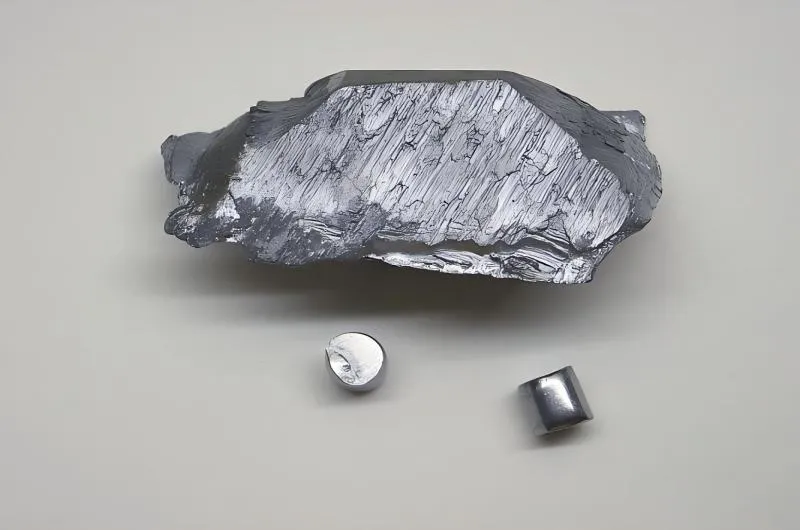BY  GENN
GENN
2024/12
Blog
Why Is Vanadium Used In Tools?
Vanadium, with the atomic number 23 and symbol V, is a versatile transition metal that holds a significant place in the periodic table.
Properties of Vanadium
The Strength and Hardness of Vanadium
Vanadium possesses exceptional strength and hardness, making it a highly sought-after element in the manufacturing of tools. Its atomic structure, characterized by tightly packed atoms and strong metallic bonds, contributes to its robust mechanical properties.
When alloyed with steel, vanadium enhances the hardness of the material, resulting in tools that can withstand heavy loads and intense pressure without succumbing to deformation or breakage. This remarkable strength makes vanadium an indispensable component in the production of high-performance tools used across various industries.
Resistance to Corrosion: A Formidable Attribute
One of the most remarkable qualities of vanadium is its unparalleled corrosion resistance. When exposed to harsh environments or corrosive substances, vanadium remains largely unaffected due to its inherent ability to form a protective oxide layer on its surface.
This corrosion resistance ensures that tools made with vanadium retain their integrity and functionality over extended periods, even when subjected to challenging conditions. As a result, manufacturers prefer vanadium-enhanced tools for applications where corrosion poses a significant threat to tool longevity.
Enhancing Steel Properties with Vanadium
Vanadium exerts a transformative influence on steel when used as an alloying element. By introducing controlled amounts of vanadium into steel compositions, manufacturers can significantly improve the material’s properties. Vanadium refines the grain structure of steel, enhancing its toughness, wear resistance, and overall performance.
This strengthening effect allows for the creation of cutting-edge tools that exhibit superior durability and reliability in demanding operational settings. The synergy between vanadium and steel underscores the vital role this element plays in elevating the quality and effectiveness of modern tools.
Vanadium in Tool Making
Alloying with Steel to Create High-Strength Tools
Vanadium plays a crucial role in the production of high-strength tools by being alloyed with steel. When vanadium is added to steel, it forms very fine carbides, which enhance the strength and hardness of the material. This process results in tools that are more durable and resistant to wear and tear, making them ideal for heavy-duty applications. The addition of vanadium also improves the machinability of steel, allowing for easier shaping and forming of these high-strength tools.
Impact on Tool Durability and Longevity
The incorporation of vanadium into tool alloys has a significant impact on their durability and longevity. Vanadium contributes to the formation of a fine-grained microstructure within the steel, which increases its resistance to deformation and cracking under stress. This translates into tools that can withstand harsh working conditions without succumbing to wear or breakage easily. As a result, vanadium-enhanced tools have a longer lifespan compared to conventional tool materials, reducing the need for frequent replacements and maintenance.
Enhancement of Cutting Performance
One of the key benefits of using vanadium in tool-making is the enhancement it brings to cutting performance. Tools alloyed with vanadium exhibit superior cutting characteristics due to their increased hardness and strength. This allows for more efficient material removal during machining operations, resulting in faster processing times and improved productivity. Whether used for cutting hard materials like stainless steel or drilling through tough surfaces such as concrete or masonry, vanadium-enhanced tools deliver precision cuts with minimal wear on the cutting edges.
Advantages of Using Vanadium in Tools
Increased Wear Resistance
Vanadium, when alloyed with steel to create tools, imparts exceptional wear resistance properties. This means that tools containing vanadium can withstand the abrasive forces encountered during cutting, drilling, or shaping operations without succumbing to wear and tear easily.
The presence of vanadium enhances the tool’s ability to maintain its shape and sharpness over extended periods of use, making it a preferred choice for industries where tool longevity is crucial. Moreover, vanadium’s high wear resistance is particularly beneficial in applications where tools are subjected to harsh conditions involving high temperatures and friction.
The robust nature of vanadium-enhanced tools enables them to retain their integrity even under extreme heat and pressure, ensuring consistent performance and reliability in challenging work environments. This distinctive characteristic sets vanadium apart as a valuable element in tool manufacturing, providing a competitive edge to tools crafted with this alloy.
Reduction in Tool Replacement Frequency
One of the most significant advantages of utilizing vanadium in tools is the remarkable reduction in tool replacement frequency it offers. Tools made with vanadium exhibit prolonged durability and resilience against wear compared to conventional counterparts. As a result, industries benefit from decreased maintenance costs and downtime associated with frequent tool replacements.
This not only enhances operational efficiency but also contributes to cost savings over time by minimizing the need for continuous tool replenishment. By incorporating vanadium into tool production processes, manufacturers can provide customers with long-lasting tools that deliver consistent performance throughout their lifespan.
The extended durability provided by vanadium alloyed tools translates into higher productivity levels for users who can rely on their equipment without disruptions caused by premature tool failure. The reduced frequency of replacing worn-out tools underscores the economic advantage that vanadium brings to various industrial applications.
Improved Tool Performance
Vanadium’s influence on tool performance extends beyond just enhancing wear resistance; it also elevates cutting efficiency, precision, stability, and reliability. Tools containing vanadium demonstrate superior cutting capabilities due to their ability to maintain sharp edges even when exposed to tough materials or demanding tasks.
This results in smoother cuts, finer finishes, and increased precision during machining operations—factors that are crucial for achieving desired outcomes in manufacturing processes. Furthermore, the incorporation of vanadium enhances the overall stability and reliability of tools by providing them with structural integrity and consistency in performance under varying operating conditions.










